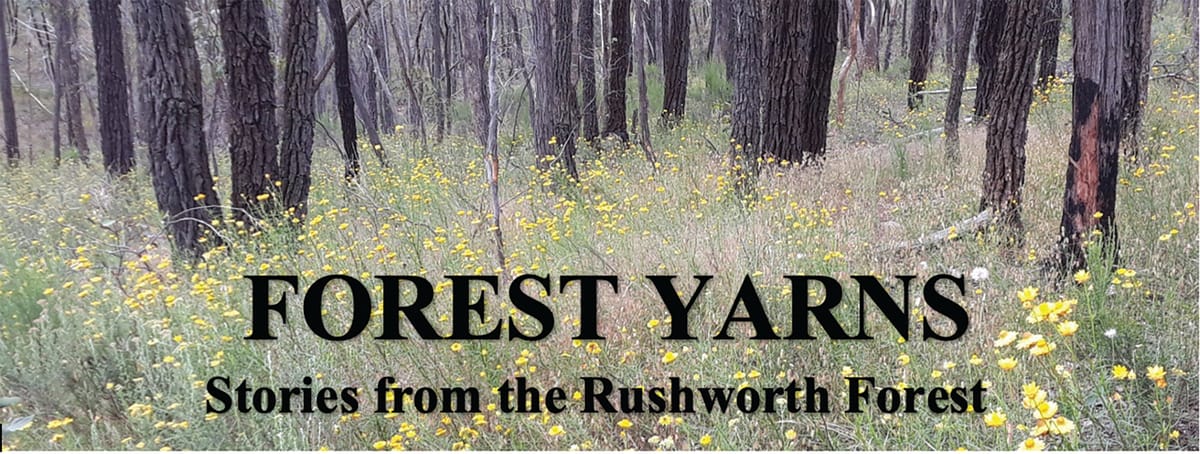Early days of sleeper cutting

Early days of sleeper cutting
The last few stories have focussed on the sleeper cutters of the Rushworth Forest. They had a tough life working out in the forest, getting minimal return for their highly skilled work, while at the same time enduring plenty of changes in government policy and regulations.
Sleeper cutters were already in demand in the early 1880s, well before the railway line to Rushworth was completed in 1890. This is evidenced by the following advertisement in the Nagambie Times (9.11.1883) – WANTED SLEEPER CUTTERS to hew Sleepers at Coy’s Diggings (Bailieston) or anywhere within five miles of Ponting’s Punt. Good men make 14s. ($1.40) per day. Apply by letter to M. MALONE, Coy’s Diggings.
A later visitor to the Waranga area in 1889 described his observations – “As we proceed up the flat (between Graytown and Redcastle), camps of sleeper cutters are seen. This must be a very lonely life for some of their women. So far as could be gathered, three sleepers is the average per tree, they being 9 feet long 9 inches wide and 4 inches thick. The cutters get 3s 9d (about 40c) on delivery, but as they have not teams of their own, they give the teamster 1s each for cartage…The sleeper cutter uses a formidable looking instrument for squaring the sleepers, having a head 10 inches long and very heavy (i.e. a broad axe).”1
Shortage of resource
These sleeper cutters were some of the early ones to work in the forest. Later, it was much harder to access trees that would produce three sleepers from one trunk. There were constant requests from sleeper hewers to gain access to new areas where they could harvest timber of reasonable size.
As early as 1890, Waranga Shire Council received a letter from the Lands and Survey office, stating that “in consequence of the very grave nature of the timber destruction going on now, caused by sleeper hewers, it has been deemed necessary not to allow timber to be cut under 24 inches in diameter.”2 The hewers themselves argued that their methods did not lead to much waste.
In 1895 the Minister of Forests made a decision to ban sleeper hewing in the Moormbool (Rushworth) Forest.3 Deputations to government were made, protesting the ban, which was overturned. Then, some new areas were opened up. “According to a notice in last week’s (Government) Gazette, permits may now be obtained to cut or hew and take away railway sleepers from all the State Forest, timber reserves, and open Crown Lands included in the parishes of Whroo, Bailieston, Wirrate, Cherrington, Dargile, Costerfield, and Gobarup.”4 This trend continued later in the decade up to 1900, when “a large number of new licences have been issued for sleeper hewing in the Moormbool state forest, and at Toolamba.”5
Other options
Options other than the Rushworth Forest were seized upon, if and when they became available. When land was being cleared for Waranga Basin, sleeper hewers were given access to some of the timber. At the same time, the men were allowed into Doctor Swamp near Murchison.
Around 1910, the then Forests Department (forerunner to FCV) allowed sleeper hewers to source timber on land that had already been surveyed for settlers, much to the chagrin of the settlers who saw the timber as theirs. By this time, however, much of the land that was used for grazing and cropping had already been cleared, so that was no longer available as a source for sleeper hewers.
By 1914, it was claimed that there was still “upwards of 50 sleeper hewers…constantly hewing and supplying at Rushworth 1,500 to 2,000 sleepers per week. These were cut from the forest and private property and delivered and stacked upon the line at 3s 1d (31c) per sleeper.”6 This implies that the average man was hewing 30 to 40 sleepers per week. Other estimates of the weekly output per worker was less than this, so this may have been an exaggeration.
The reality was that suitable timber was in short supply by the 1920s, and moves were made by the government to limit the number of sleeper cutters in the forest. Pre-World War 1 there were probably 40-50 men legally working there, but by the late 1920s the numbers were down to a dozen. There was a brief resurgence in periods of need e.g. when there was high unemployment in the 1930s and during World War 11. However, the numbers of sleeper hewers never again reached the heights of the late 19th and early 20th centuries.
References: 1 Bendigo Advertiser 10/8/1889; 2 Elmore Standard 5/9/1890; 3 The Argus 9/2/1895; 4 4 Elmore Standard 4/12/1896; 5 Tatura Guardian 17/2/1899; 6 Murchison Advertiser 27/3/1914










